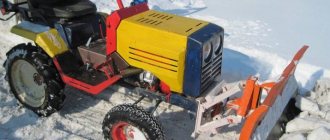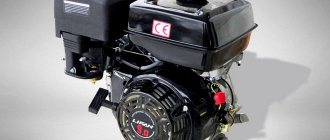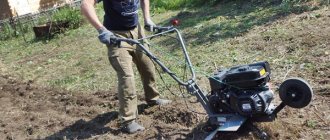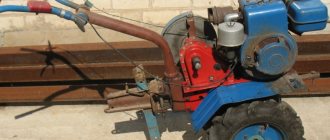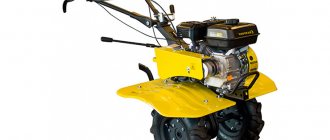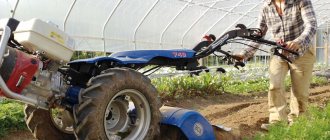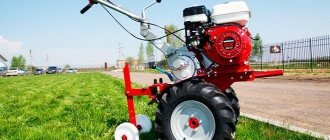Low-octane brands of gasoline - AI-76 and AI-80 disappeared from responsible gas stations almost ten years ago, but the question of what to do with equipment originally designed for them does not lose its relevance to this day. Thousands of users have become convinced that thoughtlessly pouring 92 or 95 into carburetor equipment is a very risky business, which can lead to undesirable consequences.
This does not bypass walk-behind tractors, for the power part of which the “meeting” with the latest fuel modifications becomes a real test of endurance. We will consider further why this happens and how to transfer cultivators from AI-76 to AI-92 fuel.
Video review
To see the motor cultivator in operation, and also to evaluate its capabilities before purchasing the unit, we suggest watching the video review.
Every owner of a summer cottage, one way or another, has a need to care for a vegetable garden, flower beds, or simply plow the soil for sowing lawn grass. Equipment such as the Mole cultivator copes with this task perfectly.
The unit is used for various types of soil treatment: loosening, digging to add fertilizer, weeding, hilling, pumping water. The equipment can be used not only for its intended purpose - in the summer, spring and autumn, the device will serve as an excellent transporter.
Transition from 80 to 92 gasoline - how to convert a walk-behind tractor yourself?
Many owners of agricultural equipment are trying to change the type of fuel consumed by their units. Converting a walk-behind tractor to another “diet” is not easy, but there is nothing overly complicated in such an event. Let's look at methods for performing this operation yourself.
Converting an engine to run on a different fuel - what are the advantages?
Even novice gardeners and gardeners know that grade 92 gasoline is much higher quality than cheaper fuel analogues. However, is it possible to pour 92 gasoline instead of 80 into a walk-behind tractor? Every expert will confidently answer “no.”
Even if your walk-behind tractor has a reliable design and high quality parts, it still will not work for a long time on fuel that is not standard for it. Cheaper walk-behind tractors do not start at all after changing the brand of gasoline.
Because of this, in order to refuel your equipment with good fuel, you have to slightly alter its design. As a result of the changes, the owner of the walk-behind tractor receives the following benefits:
- Extending the life of important parts and components of the unit;
- No need to change seals and filters every few months;
- Increasing the service life of the motor and gearbox;
- Less fuel consumption.
All these advantages encourage equipment owners to start working without hesitation. There are two ways to convert a walk-behind tractor to use 92 gasoline instead of 80. Below we will consider each of them separately.
Ignition timing adjustment method
This method is best described using the example of the UMZ-341 motor. This universal engine is equipped with almost the same parts as other domestic and imported engines.
Before converting a walk-behind tractor engine from 80 to 92 gasoline, you will need to replace spark plug A 11-3 with spark plug A17B. After this, you can begin to adjust the advance angle to move it no more than 2 degrees counterclockwise. The work algorithm looks like this:
- Completely drain the gasoline from the gas tank of the walk-behind tractor;
- Start the engine and give it time to burn out all remaining fuel;
- Remove the spark plug tip;
- Remove the 4 bolts holding the fan shroud;
- Remove the casing;
- Next, you will need to unlock the flywheel fixing nut;
- Unscrew the nut and remove the ratchet;
- Install the flywheel puller. To do this, tighten the puller screw and lightly hit it with a hammer;
- Find the ignition adjustment mark;
- Use a screwdriver to loosen the magneto. After this, move its base 2 mm to the left.
After completing these procedures, you need to assemble the engine. During assembly, make sure there is a key on the end of the crankshaft. Tighten the flywheel mounting nut to a torque of 16 kgf/m and secure with a lock washer. While doing this, work with the part that is not jammed. After the modification, you can confidently fill the tank of your walk-behind tractor with 92 gasoline - the unit will work like clockwork.
Method for increasing engine compression ratio
This method is a little more complicated than the previous one. All work must be done as accurately as possible so as not to damage the motor of the walk-behind tractor. The essence of the method is based on removing a layer of metal no more than 2.5 mm thick from the plane of the cylinder head. Thanks to this kind of grinding, the engine compression rate increases to 7.8 atm. In addition, you will also have to replace the spark plugs - new datleys must have a heat number of at least 16 units.
As an alternative to this method, you can replace the cylinder heads with elements of grade 421. 1003010. However, in addition to replacing the head, you will need to replace the valve rods of the pushers. For this purpose, you can buy a special set of push rods and adjusting screws
It is important to remember that the kit, like a new cylinder head, will not be cheap. Therefore, it is best to spend a little of your time and adjust the ignition timing
What awaits the owner of a walk-behind tractor after switching to a new type of fuel?
In order to successfully use 92 gasoline instead of 80, after the conversion you will have to adhere to certain rules when operating the equipment. Having studied and observed them, the owner of a walk-behind tractor will not make mistakes typical of most inexperienced farmers. During operation, you must ensure:
- Depending on the condition of the cylinders, carbon deposits formed by gasoline vapors may accumulate on their walls;
- For the serviceability of the transmission - at first it may “fail” when changing gears;
- If strange sounds appear, they indicate a motor malfunction.
After remaking the walk-behind tractor, experts advise not to overload the equipment for the first few months. Short pauses will help avoid unwanted breakdowns.
Ural with ZiD engine
Small batches of walk-behind tractors were equipped with a ZiD-4.5 power unit. The design of the motor is not very different from the UMZ-5V. The crankshaft contains a pulley and a sprocket for driving the chain. The pulley is located on the flywheel side, the chain drive is located on the gearbox side. The chain drive is used to drive stationary installations. The engine is lubricated by splashing; oil is supplied by a plunger pump from a sump that holds 1.5 liters of liquid.
A belt drive is used to transmit torque from the engine to the transmission. The belt for the walk-behind tractor has a size of 1120*17*11 mm. The walk-behind tractor uses a 2-speed transmission, the design and control of which are similar to machines with a UMZ-5V engine. The gearbox has 2 speeds, reducing the rotation speed by 17 and 7 times, respectively. The gears are changed using a handle. Before starting to operate the walk-behind tractor, you need to check the level and add transmission oil to the gearbox. The nominal crankcase capacity is 1.5 liters.
The engine ignition system includes a magneto that provides a constant ignition timing. As wear occurs, the angle changes, which leads to unstable ignition operation. To adjust the ignition of the walk-behind tractor, it is necessary to control the moment when the breaker contacts begin to open and the maximum gap between them. The check is carried out with the flywheel removed by aligning the notch on the crankshaft with the notch on the base of the magneto armature.
The power system includes a K16N or ZiD-12 carburetor and a fuel tank holding 8 liters of gasoline. Adjusting the carburetor of the walk-behind tractor allows you to ensure uniform engine operation and the fuel consumption declared by the factory. The adjustment is performed with the engine warm by rotating the idle speed screw and the throttle limiter screw. This sets the minimum idle speed.
Proportions of oil and gasoline for a walk-behind tractor. Preparing the fuel mixture
Preparing the fuel mixture
Consequences of failure to comply with recommended proportions
Two-stroke engines run on a gasoline-oil mixture. The main cause of the malfunction is an incorrect proportion of the fuel mixture or a complete lack of oil in gasoline. When preparing the fuel mixture, special oil for two-stroke engines labeled “For garden equipment” is used. Do not use oil for boat engines, motorcycles, etc... The gasoline/oil mixture ratio may vary depending on the engine model, oil labeling and recommendations of the gas tool manufacturer. For two-stroke engines, mixture ratios of 50:1, 32:1 and 24:1 are used.
In conditions of insufficient lubrication or when running on pure gasoline, the engine can run for quite a long time. A characteristic sign of long-term operation on pure gasoline is increased vibration and the sound of uneven engine operation. Shallow scuffs form on the piston and cylinder along the entire height of the side surface. In this case, the piston ring may be destroyed.
As a result of a lack of lubrication, metal transfers from the piston to the cylinder walls and the engine jams.
An excessive amount of oil in the fuel mixture leads to coking of the piston ring and the formation of intense carbon deposits on the piston.
Also, the formation of intense carbon deposits on the piston can be caused by prolonged operation of the engine with the carburetor air damper closed.
Also a sign of an engine operating with an excess amount of oil in the fuel mixture is the presence of carbon deposits on the spark plug and severe coking of the muffler screen, which results in a loss of engine power during operation.
Let's look at some signs that indicate the user does not comply with the recommendations of the Operating Instructions regarding the use of fuel of inadequate quality and storage of the lawn mower.
If you use dirty gasoline to prepare the fuel mixture, dirty deposits will be present in the carburetor.
Another sign of using dirty fuel will be a dirty fuel filter located in the gas tank.
A sign of long-term storage of lawn mowers with fuel is oxidation of carburetor elements. In this case, the elastic properties of the rubber diaphragm of the fuel supply control system and the fuel pump membrane change. It is also possible that there may be tar deposits on the carburetor elements.
Practical recommendations:
Manufacturers of gasoline-powered tools recommend adhering to the following proportions when preparing the fuel mixture:
- when using mineral oil for two-stroke air-cooled engines, maintain a gasoline/oil ratio of 40:1.* - when using synthetic oil for two-stroke air-cooled engines, maintain a gasoline/oil ratio of 50:1.*
Use oil labeled “For garden equipment.” Do not use oil for boat engines, motorcycles, etc.
Communities DRIVE2 At the Dacha Blog 95 or 92?
Hi all! I would like to know what kind of gasoline you pour into your instrument... And how do you preserve it for the winter, with or without gasoline? Your experience in this direction is interesting.
And the third reason for the breakdown: incorrect starting of the engine with a manual starter.
Many 4-stroke engine users think that the harder you pull the starter handle, the better the engine will start. This is wrong. The starter handle must be pulled until the cams engage and then pulled upward smoothly, but with a large amplitude. And the engine (if it is working properly, of course) will definitely start.
LEARN TO START YOUR ENGINE CORRECTLY.
Call. We will be happy to answer questions related to the operation of air-cooled engines Honda, BriggsStratton, Mitsubishi, Subaru-Robin, Lifan, Carver, Loncin, Champion.
Malfunctions and their elimination in the Mole motor-cultivator
Every piece of equipment that is used to perform a large volume of work breaks down over time. There can be many reasons for this, for example:
- The working life of the part is nearing its end.
- Defective components installed on equipment during the assembly process.
- Incorrect operation.
- Late and superficial maintenance.
- Excessive loads on the walk-behind tractor, as a result of which parts fail faster.
- Error in assembly at the factory.
All these reasons lead to the fact that technology can:
- Wedge.
- Refuse to start.
- No spark when turned on.
- Gearbox failure.
- Failure of the walk-behind tractor belt.
In this video we will look at how to repair a motor cultivator:
All these malfunctions make further operation of the equipment impossible, and not everyone knows how to fix them. Let's look at each problem situation in more detail and decide on the algorithm of actions if it arises.
Does not start
If the walk-behind tractor refuses to start, do the following:
- Check the condition of the drain hole located in the fuel tank. If it is clogged, the motor will not work.
- Inspect the air filter. If it becomes clogged and fails, replace it with a new one.
- The spark plug may be faulty, preventing the engine from starting. There are many reasons for the problem, and we will consider them separately.
- If a flame bursts out of the muffler while working on equipment, this is bad. This may cause the flywheel key to become deformed and you will have to replace it.
- Check the condition of the cylinder seals.
- Make sure the gasket between the filter and the carburetor is in good condition. During the assembly process, it may have been installed incorrectly, or it may have worn out.
High-quality care of equipment will increase its service life
- Stopper sludge clogged. This happens after winter, when the walk-behind tractor sits idle in the garage. During this time, various debris accumulates around the needle, which interferes with further operation of the system.
- Make sure that the fuel used to start the walk-behind tractor meets the manufacturer's requirements and is of high quality. If this is not the case, the equipment will work intermittently, and in the future it will not start at all.
- The magneto, which acts as an ignition coil on the walk-behind tractor, has failed. In this case, replace the faulty part with a new one.
Owners of walk-behind tractors who are not confident in their abilities should contact specialists who will carry out diagnostics and identify all faults. Trying to do it yourself for the first time can only make things worse.
No spark
Engine failure can occur due to a faulty spark plug. Reasons why there is no spark in the engine:
Carbon deposits formed around the spark plug during operation. Eliminate the malfunction by dismantling the spark plug and cleaning the dirt from it. There is a spark, but the engine does not start. This is possible when the tip of the spark plug is wet due to fuel or oil getting on it. The solution to the problem is to replace the tip. Periodically, fuel floods the engine cylinder, causing the spark plug to become wet and prevent the spark from passing through. In this case, remove excess fuel and dry the spark plug by manually pumping the walk-behind tractor engine with the starter. The spark plug has failed
Replace the damaged part. When dismantling the spark plug, pay attention to the O-ring. It plays an important role in the system.
Wedge
The engine of agricultural machinery that is actively used can seize and fail. Reasons for this behavior:
- Not enough oil enters the crankcase, as a result of which the engine refuses to work.
- The connecting rod has failed and requires replacement.
- A scoring mark forms on the connecting rod head, in its lower part. A similar malfunction occurs if there is insufficient lubrication during startup, an error occurred when installing a part, or the piston pin is seated too tightly.
At the first sign of engine seizure, disassemble it and check the main parts and components for integrity. Deformed, damaged or failed components must be replaced immediately. Otherwise, the motor will completely fail and cannot be restored.
User manual
The operating instructions for the Ural walk-behind tractor consist of several easy steps.
First you need to prepare the walk-behind tractor for work:
- Inspect the car, check if oil or fuel is leaking;
- Set the gearbox to neutral;
- Measure the oil and fuel level in the tank and add if necessary;
- Start the engine.
To start moving, do the following:
- Switch the engine to low speed;
- Disengage the clutch mechanism and engage the gear;
- Release the clutch release lever and increase the speed;
- Start moving.
Service Features
A strong argument in favor of purchasing the Ural UMZ-5V walk-behind tractor is not only its efficient and reliable engine, but also the ability to use gasoline with any octane rating.
UMZ engine diagram
Since in winter, due to severe frosts, the consistency of the oil may thicken, it is advisable to use it in accordance with the season. Fill in oil as much as indicated in the instructions.
Running in the walk-behind tractor
An important point in extending the service life of the engine is running-in, thanks to which you can not only identify possible problems, but also prepare the walk-behind tractor for operation. It is recommended to carry out a break-in after purchase and prolonged inactivity.
The procedure is carried out as follows:
- With the gearbox in neutral, start the engine at idle speed. You can work in this mode for 5 hours without loading the walk-behind tractor.
- For the next 25 hours, it is allowed to use the walk-behind tractor at half its power.
- For the next 30 hours, run-in the device by increasing the load.
- During break-in, it is necessary to adjust the belt tension.
To get acquainted with the instructions for the Ural UMB-K walk-behind tractor in more detail, you can download it from the link: Operating instructions for the UMB-K Ural walk-behind tractor
Basic faults
The following is a list of possible faults that you can fix yourself:
- No forward or reverse. This can happen due to a break in the front/rear belt or due to insufficient tension. It is necessary to check the belts and the operation of the gearbox.
- Delamination of the V-belt drive belt. This problem can only be solved by completely replacing the belt.
- An oil leak was detected at the gearbox connector. Tighten the bolts and check the integrity of the gasket. If it becomes deformed, replace it.
- Oil leakage along the axes of the sprocket blocks and along the output shaft seals. This happens if more oil is poured than necessary or if the seals are damaged, the latter being repaired in specialized workshops.
- Doesn't start well. Check the gearbox valve.
- The spark is gone. It can fail due to irregular maintenance. Dirt gets onto the spark plug cap and accumulates there, which consequently leads to engine malfunctions. This malfunction, as a rule, only affects single-cylinder engines.
You can download the original engine repair instructions below from the link: Operating instructions for the UMZ 5V engine
Mole cultivators - what is the reason for their popularity?
These Russian-made cultivators are superior to other domestic and some imported analogues in almost all respects. This technique allows you to install a plow, cutters and various hillers. These models successfully cope with the processing of virgin soil and heavy clay soils.
As practice shows, these units are best suited for working on areas of no more than 10 acres.
Distinctive features:
- Availability of powerful two-stroke engines, mainly Honda, with power from 2 to 8 hp. With.;
- Equipped with high-quality gearboxes that can withstand high loads;
- The presence of ergonomic handles and good location of controls;
- Compact dimensions and light weight;
- High-quality sharpening of cutters;
- Processing depth 0 from 12 to 25 cm;
- The width of the covered strip is 30–110 cm.
The most compact model is considered to be the “Mole M” unit, with a power of 5 hp. With. It is suitable for plowing small areas using a wide range of attachments. If the area being treated has a large area, then it is worth considering representatives of a number of MKs - they are more powerful and reliable.
Review of the Neva MB 2 walk-behind tractor
Currently, appropriate equipment is available for soil treatment. There is no longer any need to perform all actions manually, since the appropriate special equipment is available for sale. This is extremely convenient, especially when there is a need to cultivate a large area at once. Among the abundance of auxiliary devices, walk-behind tractors deserve special attention. In this case, you need to get acquainted with the operating instructions for the popular model of the Neva walk-behind tractor, model MB 2.
You can install the lug yourself
General description of the Neva MB 2 walk-behind tractor
The design of this walk-behind tractor, like other common models, includes certain elements. Let's look at the main characteristics of the device, as well as some inherent features:
- This model is equipped with a motor made in the USA by Briggs Stratton.
- The engine power is 6 horsepower.
- The volume of the fuel tank of the device is 3.8 liters.
- Weight without attachments – 98 kilograms.
- The engine capacity is 205 cubic centimeters.
- The transmission of the device includes two forward gears and one reverse gear (2+1) × 2.
How to set the ignition on a cultivator
If the starter cable of the Neva cultivator is pulled frequently, over time the engine begins to start late. In this case:
- Place the square on the candle;
- Press the housing against the cylinder head and turn the ignition element away from the holes;
- Turn the crankshaft and tighten the cable several times;
- A spark should appear when tensioning; if there is none, the required gap between the flywheel and magneto should be adjusted.
Adjusting and tuning the magneto is quite simple. Most often, the cause of a malfunction of a walk-behind tractor coil is a spark plug. Therefore, every owner of a motor cultivator should have a set of spare spark plugs in his tool case.
The most popular spark plugs from well-known manufacturers are Bosch and Subaru.
Checking the spark plugs is done like this. In order to check the serviceability of the coil spark plugs of the MB and MB 1 walk-behind tractor, you need to follow the following instructions:
- Turn out the candle. Wipe the electrodes.
- If there is carbon deposits, clean it.
- Set the distance between the electrodes.
- Place a tip with a high-voltage wire on the spark plug.
- Press against the cylinder body. The electrodes should point in one direction under the spark plug.
- Rotate the crankshaft and observe the formation of a spark. If it is not there, then the fault is in the spark plug.
How to convert a walk-behind tractor engine from 80 to 92 gasoline?
There are 2 proven ways to complete this procedure. You can convert a walk-behind tractor not only from 80 gasoline, but also from AI-76 to AI-92. We will describe each method in detail below.
Method 1: Adjusting the ignition timing
This conversion method is easiest to demonstrate using the UMZ 341 motor as an example, since it is the most universal and is equipped with the same spare parts as most motors for walk-behind tractors.
Before starting the alteration, you should replace the A11-3 spark plug with an A17B one. After this, adjust the lead angle in the following sequence:
- Completely drain the old fuel from the gas tank.
- Start the engine (so that the remaining gasoline in the fuel system is completely used up).
- Remove the candle tip.
- Unscrew the bolts that secure the fan casing and remove it.
- Unscrew the flywheel fixing locknut and remove the ratchet.
- Install the flywheel puller. To do this, tighten the central bolt of the puller and, after hitting it lightly with a hammer, remove the flywheel. When removing the flywheel, do not hit it.
- Find the factory ignition installation mark.
- Use a screwdriver to loosen the magneto mount and turn its base counterclockwise by 2 mm.
Once all steps are complete, assemble the motor. Make sure all parts are present and in the correct position, and tighten all bolts and nuts. Now you can safely refuel your walk-behind tractor with 92 gasoline, enjoy its work and evaluate the results after the modification.
Method 2: Increasing the engine compression ratio
The method is a little more complicated than the previous one, it requires increased concentration and high precision of execution so as not to damage the equipment. This method involves grinding the cylinder head, as a result of which it is necessary to remove a layer of metal no more than 2.5 mm thick. After this, engine compression will be increased to 7.8 atmospheres. You should also replace the spark plugs with new ones with a heat rating of at least 17 units.
There is a safer and more accurate way to carry out this modification. Purchase a ready-made set of a new cylinder head, valve rods and pushrods and install them. But such a replacement will cost money.
The methods described above for converting walk-behind tractors are suitable for many models of walk-behind tractors, including models such as Neva MB1 and MB2, MTZ-05 and MTZ-12, modifications of walk-behind tractors of the Agro and Cascade brands.
Method 2: setting up the ignition
Another way by which you can transfer the engine of an Agro or Cascade walk-behind tractor to AI-92 is to re-adjust the initial ignition timing.
The process looks like this:
- empty the fuel tank;
- turn on the engine, giving the opportunity to use up the remaining gasoline in the carburetor;
- remove the tip of the spark plug;
- unscrew the bolt ties that hold the fan protection;
- remove the casing itself;
- loosen the flywheel tie;
- remove the ratchet and accompanying nuts and bolts;
- unscrew the central pin that holds the flywheel and pull it out of the housing;
- we determine where the installation mark for the ignition is located, marked on the class=”aligncenter” width=”400″ height=”265″[/img]
- take a screwdriver and slowly turn the magneto fasteners;
- carefully move the latter 2 mm to the left (counterclockwise);
- We begin assembling the motor block in the reverse order of disassembly.
During the assembly process you need to take into account that:
- a key was installed on the crankshaft;
- the flywheel nut was tightened with a force of no more than 16 kg/s and was covered with a locking washer on top;
- Instead of the old spark plug, a new type A17B was installed.
After this, the engine can safely run on AI-92 fuel.
4th method: we transfer the equipment to 92nd gasoline by lowering its octane number
Unlike others, it is very light.
It can be implemented in several ways:
active - when the properties of 92 gasoline are purposefully changed:
- adding special additives. Sulfur-based compounds or resin fractions are often used as “reducers”;
- by diluting 92 gasoline with diesel fuel. The best option is when the amount of kerosene does not exceed 10%. However, experimentally it can be adjusted to a specific walk-behind tractor model.
passive - it is associated with a natural decrease in octane number during long-term storage.
Why is this happening? As you know, any gasoline is a mixture of several fractions - light and heavy. The former contribute to starting the walk-behind tractor when cold, and the latter – to stable operation after warming up. Considering that modern fuel production technologies involve the addition of highly volatile additives - ethers, alcohols, and in the past - tetraethyl lead, they all evaporate after a certain period of time. Depending on the quality of the original fuel, the evaporation rate can be from a third to a half of an octane unit per day.
What does that require?
The main thing is not to tightly close the container filled with 92 and leave it for several weeks.
The rate of evaporation will depend on:
- volume of gasoline filled into the tank;
- neck size;
- storage conditions.
Despite its advantages, this method has one significant drawback - the inability to find out the exact octane number of the resulting fuel at home. For this you need a good laboratory or, at a minimum, an expensive express device.
The methods discussed above are universal: they work perfectly both for the Krot or MTZ walk-behind tractors, and for later developments - Agro and Neva MB-1 or MB-2. They are a real alternative to extend the life of your outdated equipment and avoid expensive replacement of the motor part or purchase of a new cultivator.
3rd method: by installing additional gaskets (changing the gasket)
If the previous methods of converting a walk-behind tractor to 92 gasoline seem too labor-intensive, you can limit yourself to simpler ones. The first of them is based on the fact that the cylinder head is reinforced with 3 additional gaskets at once. The middle one will remove excess heat. It is ideal if you have silumin or another made of light alloy material on hand.
All of them must be commensurate with each other. It is important to calculate the thickness of the middle gasket.
To do this, use the formula (all in mm):
Vsr = 4 mm - (Vv + Vn) + 0.7 mm (shrinkage coefficient), where:
Вв – height of the upper gasket;
The valve pushers that were on the old MTZ-05 or MTZ-12 walk-behind tractor may remain old. Only their rods need to be replaced (they are needed shorter than in the design for 80-octane gasoline).
The second is the usual replacement of the gasket between the cylinder and the cylinder head. The standard ones are replaced with more durable ones, for example, made from paranite.
As you can see, after minor modifications, the walk-behind tractor can operate stably on high-octane gasoline.
Diesel options
Among the Krot cultivators there are also diesel models. They are based on a G170F engine, which provides increased traction and allows you to cultivate virgin lands. In addition to the reinforced frame, such walk-behind tractors received pneumatic wheels.
WG351
Of all the diesel variants of the Mole, this particular model is equipped with a reduced-power engine. In terms of technical characteristics, this is an average version of agricultural machinery for small farms.
| Power, hp | 6.0 |
| Engine volume, cm3 | 296 |
| Tank volume, l | 3.5 |
| Weight, kg | 138 |
| Working width, cm | 120 |
| Plowing depth, cm | 30 |
| Clutch | disks |
| Transmission | gear |
| Number of gears | 3 (2+1) |
| Wheels, inches | 10 |
WG352
The main difference from the WG351 model is the presence of an electric starter. In terms of technical characteristics, there is otherwise no significant difference: this unit also runs on a four-stroke diesel engine, its power remains 6.0 hp. The only negative is the narrowed cutters with a processing width of 110 cm. A plus is considered to be a reduction in the total weight by 18 kg.
WG353
The most powerful walk-behind tractor in the entire diesel line. Powered by a 4-stroke engine with an air cooling system.
| Power, hp | 9.0 |
| Engine volume, cm3 | 418 |
| Tank volume, l | 5.5 |
| Weight, kg | 145 |
| Working width, cm | 110 |
| Plowing depth, cm | 30 |
| Clutch | disks |
| Transmission | gear |
| Number of gears | 3 (2+1) |
| Wheels, inches | 10 |
Mole cultivators, regardless of their power, are considered one of the most reliable types of small agricultural equipment. Malfunctions that may arise during operation can be corrected independently, without the help of specialists. Most often, breakdowns are associated with the gearbox, which begins to make unnecessary noise when there is a lack of oil or when the components become loose. Motoblocks can work tirelessly for up to 10 years. With careful use of equipment and timely replacement of consumables, farmers manage to extend the life of the cultivator several times.
What kind of gasoline should I pour into the MTZ walk-behind tractor?
Oil for walk-behind tractor MTZ Belarus 08N-09N
| Name of assembly units | Name and designation of fuel and lubricants brands | |
| Fuel tank | Gasoline A-92 TU 38.001.165 | Not available |
| Engine oil crankcase | SAE 10W-30 | Same |
| Transmission | In summer (above plus 5°C) | |
| Motor oils: M-10V2 or M-10G2 GOST 8581 | Motor oil M-bz/10V GOST 10541 | |
Design
The design of this model is so primitive that some craftsmen are trying to assemble a Mole cultivator with their own hands. The frame consists of two half-frames bolted to the gearbox. At the rear of the walk-behind tractor there are tubular control handles and a platform for installing attachments. Engine and clutch speed controls are located on the handles.
Soil steel cutters are fixed on the output shafts of the gearbox. There are four of them in the basic versions, but there are options that work with six cutters. Their diameter is 320 mm, which allows you to cut through the ground to a depth of 25 cm. Considering the main purpose of this walk-behind tractor, this size is quite justified. The cultivator does an excellent job of plowing and removing small weeds.
The internal combustion engine is mounted on the frame of the Mole cultivator and connected to the input shaft of the gearbox via a V-belt transmission. The engine of the basic modifications of this agricultural machinery is the simplest - a single-cylinder two-stroke with an air cooling system. It is equipped with a dry air filter and a non-removable manual cable starter. “Mole” runs on gasoline or diesel. Engineers placed the fuel tank on top.
Improved versions are equipped with imported two- and four-stroke engines, which increases the endurance of the equipment when processing difficult soils. The model range includes devices with electric motors, which are in demand when processing closed greenhouses.
Regardless of the option, “Mole” is equipped with five oil seals that guarantee tight connections. This is one of the preventative measures for an engine that stops working if the seal is broken as a result of loosening.
Technical characteristics of the Mole walk-behind tractor
The Mole walk-behind cultivator is equipped with a two-stroke engine, a carburetor and forced air cooling. The engine and gearbox are attached directly to the frame. The output shaft of the gearbox is connected to the motor using a V-belt drive. 2 tubular handles extend from it to control the device. With the help of the latter, the clutch, speed and reverse are controlled, if the model has such a function.
The Mole walk -behind cultivator is equipped with a two-stroke engine
The modification determines what Mole . All models have the following features in common:
- the average speed is 5-6 thousand per minute;
- the unit has a single-cylinder two-stroke engine, so it is fueled with a mixture of A-76 gasoline and oil in an approximate ratio of 25:1;
- the entire range of devices has transport wheels for moving walk-behind tractors when they are turned off;
- The coulter is included in the delivery set and is used to adjust the depth of tillage;
- The mechanism is started using a manual starter.
behind tractors , the technical characteristics of all models of which are similar, have the following basic parameters:
- dimensions: length – 100-130 cm, width – 35-81 cm, height – 71-106 cm;
- the fuel tank holds up to 3.6 liters of fuel;
- productivity – up to 200 sq. m. per hour;
- tillage width – 35-60 cm, depth – up to 25 cm;
- Engine power ranges from 2.6 to 6.5 liters. With.
All walk-behind tractor models have common features
What awaits the owner of a walk-behind tractor after switching to a new type of fuel?
In order to successfully use 92 gasoline instead of 80, after the conversion you will have to adhere to certain rules when operating the equipment. Having studied and observed them, the owner of a walk-behind tractor will not make mistakes typical of most inexperienced farmers. During operation, you must ensure:
- Depending on the condition of the cylinders, carbon deposits formed by gasoline vapors may accumulate on their walls;
- For the serviceability of the transmission - at first it may “fail” when changing gears;
- If strange sounds appear, they indicate a motor malfunction.
After remaking the walk-behind tractor, experts advise not to overload the equipment for the first few months. Short pauses will help avoid unwanted breakdowns.
In fact, 80-grade gasolines were illegal in our country until recently. Back in 2008, with the introduction of the Technical Regulations on fuels, it was popularly explained to us: they are bad, environmentally dirty and are in no way suitable for the foreign cars of officials and deputies. Therefore, they were not even included in environmental class 2, the lowest according to the Regulations.
The entry into force of this tricky document has been repeatedly postponed. Finally, in the fall of 2011, when only class 4 gasoline should have been sold throughout Russia (according to the first edition of the Regulations), it turned out that the majority of refineries had not even reached class 3 (such fuel was allowed to be produced until the end of 2009)! At the same time, further amendments were adopted, which... abolished all restrictions on the octane number. Now it is possible, without looking at the timing, to produce any gasoline, be it 72nd or 110th, as long as all other requirements for the environmental friendliness of the fuel are met.
However, the process has begun: oil workers have been curtailing production of 80-grade gasoline since 2008. Today, although it is “legal”, it is in terrible short supply! And since the largest refineries have stopped producing it altogether, this brand is brought from old factories that did not have time to wake up with the introduction of the Regulations, or from semi-handicraft mini-refineries, where they obtain cheap low-quality surrogates by distilling gas condensate. As a result, refueling with 80 has now become complicated, relatively expensive, and unpredictable in its consequences!
What should we feed the old dinosaurs? There are ZILs and Muscovites here, and old motorcycles, and outboard motors... Won't they feel bad? Let's check.
Features of operating a converted walk-behind tractor
In order to extend the life of the main mechanisms of the converted walk-behind tractor, be sure to adhere to a number of rules. When operating an agricultural machine, do the following:
- checking the condition of the cylinders - regularly inspect parts for the appearance of soot, which is formed as a result of fuel evaporation;
- checking the serviceability of the transmission - at first it may “fail”, but later all the parts will fall into place and the mechanism will work properly.
Technical features for different jobs
Each of the types of work performed by a motor-cultivator has its own technical features in the preparation and attachment of the corresponding mounted implements, and the technology of execution:
- Milling, loosening, weeding - with this type of work, the cutter is installed on the gearbox shaft, and the loosening depth is set using the coulter. After starting the engine, the unit goes deep and begins to move forward along the treated area with smooth pushes.
- Planting potatoes, hilling - the cutter is removed from the gearbox shaft, and metal wheels with lugs are installed. The rear support wheels are removed and a single-body hiller is installed on the cultivator. When planting, cut a furrow, manually place a potato seed in it, and then use the same hiller to fill up the row planted in this way. When hilling, instead of wheels with lugs, protective wheels are installed on the gearbox shaft. The formation of the ridge occurs when the hiller moves between two rows of crops.
- Harvesting potatoes - remove the cutter and support wheels from the motor cultivator, install metal wheels with lugs and a fan potato digger. They dig up potatoes, using such attachments, directing them exactly in the center of the row. At the same time, the body of the potato digger lifts the tubers, which, falling on the fan of twigs, are freed from the ground and, falling from them, remain lying on the soil.
- Mowing grass - for mowing, the front cutter is removed and rubber-coated iron wheels are installed in its place. The segmented walk-behind mower is connected to the front of the cultivator frame; it is driven by a belt installed on the pulleys of the unit and the cultivator engine.
- Water pumping - the pumping station is installed in front of the cultivator. The pump, like the mower, is driven using a V-belt drive. To pump out water, an intake hose with a filter and a discharge hose are put on the corresponding pipes of the pumping station (lowered into a container).
- Transportation of goods - rubber-coated metal or pneumatic wheels are installed on the gearbox shaft, the support wheels and the coulter are removed, in place of the latter a coupling device is installed, to which the cart with the body is attached using a finger. The trolley transports bulk and other cargo weighing no more than 200 kg.
Important! When digging potatoes with a conveyor potato digger and mowing tall grass, in order to increase the traction force and productivity of the unit, a factory or homemade speed reducer is installed on it
Methods
First, we need to determine. It is best to use a regular portable device for this. Popular is, for example, OKTIS-2. The cost of such devices is 4-6 thousand rubles. Perhaps you can find it cheaper. Unfortunately, you can’t do without such a device. There is no way to make 80 gasoline out of 92 without knowing the current octane number after manipulations with the fuel.
The easiest way is to add low-octane fuel to AI 92 gasoline - AI 76, for example. Considering that the latter is practically not sold anywhere, you can add sulfur compounds to gasoline. It can also be diluted with AI 80 gasoline, but it will not be possible to seriously reduce the octane number in this way. True, before diluting gasoline, it is necessary to measure its current octane number and measure it after each portion of fuel addition.
Question answer
What functions can the Krot walk-behind tractor perform?
In addition to the basic function of digging up soil, “Mole” will be extremely useful when planting vegetable crops, hilling, and harvesting. In addition, the “Mole” can replace a mower and also does an excellent job of clearing the area from leaves and snow.
Are there any disadvantages to the MK-1 A model?
This model has many advantages, but among the disadvantages we can only note the lack of reverse, which limits the movement of the walk-behind tractor along one path forward.
Which Krot models have reverse?
If reverse is one of the selection criteria, you should pay attention to MK 3-A-3. “Mole” comes complete with domestic engines only, or do some models use foreign-made engines?
“Mole” comes complete with domestic engines only, or do some models use foreign-made engines?
There are models that use fairly powerful foreign-made power units, for example, MK 9-012, equipped with an excellent Hammerman engine.
Does soil composition affect the choice of cultivator or does it not really matter?
Yes, this is one of the main criteria for choosing a walk-behind tractor. In cases where clay predominates in the soil or there is a high level of turf or cover crops, it is better to give preference to a disc walk-behind tractor. If the clay level is low, then purchasing a cultivator with teeth would be a rational choice.
Attachments
Initially, when creating the walk-behind tractor, it was not planned to use attachments on it. But the need to expand functionality and the wide popularity of the unit forced manufacturers to reconsider the design.
Adapter Grousers Potato Digger Blade Shovel Plow Trailer Rotary Mower Segment Mower
Currently, the walk-behind tractor uses the following types of additional equipment:
- Milling cutter - designed for processing soil, including high-density soil. Installed instead of wheels. In order to change the depth of processing, you need to adjust the opener. With this design it will work much faster. The cutter assembly diagram is shown in the photo below.
- Adapter - turns the walk-behind tractor into a miniature tractor and moving around on such a device becomes much more convenient.
- Trailer – it is used to transport goods. Convenient attachment of the cart to the walk-behind tractor will allow you to transport up to 500 kg.
- Mowers – designed for cutting grass. There are 2 types: rotary and segmental. Configurations and sizes vary, as all manufacturers try to improve the model. Segment mowers have two rows of pointed teeth that move in a horizontal plane. They are capable of cutting not only grass, but also small shrubs, but they only work on flat areas. Rotary ones operate by three knives that rotate and cut the grass. They can also work on inclined surfaces.
- Wheels, tracks - wheels are included with the walk-behind tractor, but for driving on snowy terrain it is best to use tracks, which are worn instead of wheels and increase the traction area of the machine with the ground.
- Lugs - designed for movement on viscous soil. This is a disk to which steel plates are welded in the shape of the letter V. When moving, the lug wheels reliably enter the ground and increase traction with the soil.
- Plow – mounted on a walk-behind tractor and designed for plowing the ground. It is usually used when working with cutters is ineffective. As it moves around the area, it leaves deep furrows.
- Snow blower, plow blade - are available in various configurations and sizes, among which the consumer can choose the most suitable model. The snow blower can scatter snow up to 12 m.
- A potato digger/planter is a special attachment designed for harvesting and planting potatoes. The most popular is the screen version of the potato digger. In front there is an active knife, which picks up the earth and directs it to the shaking sieve. During operation, it vibrates and breaks clods of earth, leaving only root crops on the surface.
- Weighting agents help make the walk-behind tractor heavier and make it easier to process the most difficult areas.
How to make 80 gasoline from 92?
Unfortunately, there is no specialized literature that would describe methods for lowering the octane number, since turning efficient fuel into cheap gasoline with a low octane number is uneconomical, stupid and ineffective, because the cost of 92 gasoline is higher than the cost of AI 80 gasoline. However, such a necessity sometimes it occurs.
The octane number can be lowered by:
- Sulfur compounds and resinous substances.
- Adding low-octane fuel to high-octane gasoline.
- Long-term storage of gasoline. Under incorrect storage conditions (high temperature, for example), it loses its properties. Substances in its composition that increase the octane number evaporate, and as a result, the fuel becomes of poorer quality. On average, the octane number can decrease by 0.2 units per day.
Depending on the method of lowering the octane number, we will need a single-piston engine, sulfur compounds, a portable device for determining the octane number, and low-octane gasoline.
Prices in Russia
New and used copies of the Ural Patriot are widely distributed on the domestic market. The average price of a new car is 28 thousand rubles for the basic configuration. The most equipped version will cost about 33 thousand rubles. On the secondary market you can find a walk-behind tractor with attached equipment and in good condition. This option will cost between 20-25 thousand rubles.
Among the most striking analogues of the Patriot Ural walk-behind tractor are the models Sich MB-8, Ugra NMB-1N1 Kaluga, as well as Tselina MB-801 and Daewoo Dat M 80110.
Models
Progress does not stand still and today quite modern modifications have been developed that have a fairly wide range of functions: “Krot-OM”, “Krot-2”, “Krot MK-1A-02”, “Krot-3”, and also "Mole MK-1A-01". Let us dwell on the description of the most popular models of Mole walk-behind tractors.
This is the smallest unit, equipped with a two-stroke carburetor engine with power parameters of 2.6 liters. With. Despite its size and low power characteristics, such a walk-behind cultivator can be used to cultivate fairly large plots of land; in addition, its low weight makes it easy to move the walk-behind tractor to any desired location. Such installations are most often used in greenhouses and greenhouses. The model does not have a reverse option and can only move forward, and in one single gear. Installation weight – 48 kg.
MK 3-A-3
This option is much larger than the previous one, its weight is already 51 kg, however, it can easily be moved in the trunk of any standard car. The unit is equipped with a highly productive GioTeck engine with a power output of 3.5 hp. With. The fundamental difference of this model is the presence of reverse and improved technical and operational properties, which is why working with such a device is much more comfortable and convenient.
MK-4-03
The unit weighs 53 kg and is equipped with a 4 hp Briggs&Stratton engine. With. There is only one speed, there is no reverse option. The motor cultivator has improved parameters for grasping soil in depth and width, thanks to which all necessary agricultural work is performed more efficiently and effectively.
MK-5-01
This product, in its design and operational features, is very similar to the previous one, differs in the same width and depth of grip, but the type of engine here is completely different - Honda, which is characterized by greater endurance with the same power.
MK 9-01/02
A very convenient motor cultivator equipped with a 5 liter HAMMERMANN motor. With. High productivity makes it possible to process even complex virgin soils with such a unit, and the dimensions of the device do not create any problems with its transportation and movement.
Does it make sense to lower the octane number?
In theory it makes sense, since engines designed to run on low-octane gasoline do not handle more efficient fuels well. It's all about the moment of fuel explosion: in engines that are designed for AI-92 gasoline, low-octane fuel will explode too early, and then some of the energy is lost. Detonation occurs, which leads to rapid wear of the engine friction pairs. Also, combustion products may be deposited on the cylinder walls, since they do not have time to be removed from the combustion chamber when the exhaust valve opens.
On the contrary, in engines designed for low-octane fuel, AI 92 or AI 95 gasoline will explode with some delay, which leads to approximately the same consequences. But this is in theory. In fact, it is impossible to fill modern engines with low-octane fuel, but on the contrary, it is possible. The reason is the low quality of gasoline sold at Russian gas stations. Unfortunately, its quality is worse compared to European fuel, so many drivers try to use fuel with a higher octane number than that required for the engine.
Therefore, you can safely use high-octane fuel for old mopeds, chainsaws, lawn mowers, and even add oil to gasoline for a chainsaw. And although they are designed to work with low-octane fuel, there is nothing wrong with using fuel with a higher detonation resistance.
Motor cultivator Mole MK-1A-02
The “Mole” MK-1A-02 motor-cultivator is produced domestically. The first units were produced by the manufacturer in the 80s of the last century. These devices, although they differed (in characteristics, structure, principle of launch and operation, trailed equipment, etc.) from the modern motorized cultivator “Mole” MK-1A-02, but were appreciated by the owners of vegetable gardens, greenhouses (small-sized farms ). From the very moment of its appearance, “Mole” has become an indicator of reliability, durability, functionality and high technology.
Motor cultivator Mole MK-1A
Description
The modern unit labeled MK-1A-02 has been modernized, resulting in an increase in its power (2.6 l/s) and, accordingly, productivity. A two-stroke engine running on mixed fuel (gasoline + oil) is capable of ensuring uninterrupted operation of the cultivator for a long time. The relatively light weight (only 48 kg) allows you to easily transport the equipment to any place that requires treatment with a motor cultivator.
Using the Mole cultivator, you can carry out the following agricultural work on the site:
- plowing soil of any severity;
- cutting through the soil for sowing;
- planting potatoes;
- hilling of planted plants;
- weeding;
- digging up potatoes;
- mowing;
- snow removal;
- transportation of goods, etc.
Specifications
| Parameter | Meaning |
| Manufacturer country | Russia |
| Milling cutter diameter | 33 cm. |
| Power | 2.6 hp |
| Number of speeds | 1 forward/0 backward |
| Reverse | No |
| Steering column | 1 position |
| Working width | 35-60 cm. |
| Grip depth | 25 cm. |
| Weight | 48 kg. |
| Dimensions | 1300x810x1060 mm. |
Difference between high octane and low octane fuel
Octane number has a direct effect on the rate of fuel combustion. Gasoline with a high octane number burns smoothly and for a long time, resulting in no shock loads on the pistons. Therefore, manufacturers produce modern cars whose engines are designed to use AI 92, AI 95 and even AI 98 gasoline.
Low-octane gasoline in an engine that is not designed for it burns prematurely, due to which some of the energy is wasted, detonation occurs in the cylinders, which leads to damage to the valves and the formation of deposits on the cylinder walls.





